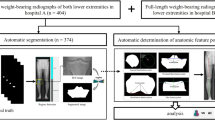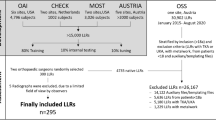Abstract
Purpose
Evaluating lower extremity alignment using full-leg plain radiographs is an essential step in diagnosis and treatment of patients with knee osteoarthritis. The study objective was to present a deep learning-based anatomical landmark recognition and angle measurement model, using full-leg radiographs, and validate its performance.
Methods
A total of 11,212 full-leg plain radiographs were used to create the model. To train the data, 15 anatomical landmarks were marked by two orthopaedic surgeons. Mechanical lateral distal femoral angle (mLDFA), medial proximal tibial angle (MPTA), joint line convergence angle (JLCA), and hip-knee-ankle angle (HKAA) were then measured. For inter-observer reliability, the inter-observer intraclass correlation coefficient (ICC) was evaluated by comparing measurements from the model, surgeons, and students, to ground truth measurements annotated by an orthopaedic specialist with 14 years of experience. To evaluate test–retest reliability, all measurements were made twice by each measurer. Intra-observer ICCs were then derived. Performance evaluation metrics used in previous studies were also derived for direct comparison of the model’s performance.
Results
Inter-observer ICCs for all angles of the model were 0.98 or higher (p < 0.001). Intra-observer ICCs for all angles were 1.00, which was higher than that of the orthopaedic specialist (0.97–1.00). Measurements made by the model showed no significant systemic variation. Except for JLCA, angles were precisely measured with absolute error averages under 0.52 degrees and proportion of outliers under 4.26%.
Conclusions
The deep learning model is capable of evaluating lower extremity alignment with performance as accurate as an orthopaedic specialist with 14 years of experience.
Level of evidence
III, retrospective cohort study.





Similar content being viewed by others
Abbreviations
- TKA:
-
Total knee arthroplasty
- OA:
-
Osteoarthritis
- mLDFA:
-
Mechanical lateral distal femoral angle
- MPTA:
-
Medial proximal tibial angle
- JLCA:
-
Joint line convergence angle
- HKAA:
-
Hip–knee–ankle angle
References
Aglietti P, Rinonapoli E, Stringa G, Taviani A (1983) Tibial osteotomy for the varus osteoarthritic knee. Clin Orthop Relat Res. https://doi.org/10.1097/00003086-198306000-00035
Ahmad SS, Kerber V, Konrads C, Ateschrang A, Hirschmann MT, Stockle U et al (2021) The ischiofemoral space of the hip is influenced by the frontal knee alignment. Knee Surg Sports Traumatol Arthrosc 29:2446–2452
Alves P, van Rooij F, Kuratle T, Saffarini M, Miozzari H (2022) Consistent indications, targets and techniques for double-level osteotomy of the knee: a systematic review. Knee Surg Sports Traumatol Arthros. https://doi.org/10.1007/s00167-022-06915-6
Babazadeh S, Dowsey MM, Bingham RJ, Ek ET, Stoney JD, Choong PF (2013) The long leg radiograph is a reliable method of assessing alignment when compared to computer-assisted navigation and computer tomography. Knee 20:242–249
Bowman A, Shunmugam M, Watts AR, Bramwell DC, Wilson C, Krishnan J (2016) Inter-observer and intra-observer reliability of mechanical axis alignment before and after total knee arthroplasty using long leg radiographs. Knee 23:203–208
Brouwer GM, van Tol AW, Bergink AP, Belo JN, Bernsen RM, Reijman M et al (2007) Association between valgus and varus alignment and the development and progression of radiographic osteoarthritis of the knee. Arthritis Rheum 56:1204–1211
Cicuttini F, Wluka A, Hankin J, Wang Y (2004) Longitudinal study of the relationship between knee angle and tibiofemoral cartilage volume in subjects with knee osteoarthritis. Rheumatology 43:321–324
Driban JB, Harkey MS, Barbe MF, Ward RJ, MacKay JW, Davis JE et al (2020) Risk factors and the natural history of accelerated knee osteoarthritis: a narrative review. BMC Musculoskelet Disord 21:332
Fischler MA, Bolles RC (1981) Random sample consensus: a paradigm for model fitting with applications to image analysis and automated cartography. Commun ACM 24:381–395
Gaasbeek R, Welsing R, Barink M, Verdonschot N, van Kampen A (2007) The influence of open and closed high tibial osteotomy on dynamic patellar tracking: a biomechanical study. Knee Surg Sports Traumatol Arthrosc 15:978–984
Gielis WP, Rayegan H, Arbabi V, Ahmadi Brooghani SY, Lindner C, Cootes TF et al (2020) Predicting the mechanical hip-knee-ankle angle accurately from standard knee radiographs: a cross-validation experiment in 100 patients. Acta Orthop 91:732–737
Greene WB (1996) Genu varum and genu valgum in children: differential diagnosis and guidelines for evaluation. Compr Ther 22:22–29
Hanson JA, Kapron AL, Swenson KM, Maak TG, Peters CL, Aoki SK (2015) Discrepancies in measuring acetabular coverage: revisiting the anterior and lateral center edge angles. Journal of Hip Preservation Surgery 2:280–286
Harris R, Strotmeyer ES, Sharma L, Kwoh CK, Brach JS, Boudreau R et al (2022) The association between severity of radiographic knee OA and recurrent falls in middle aged and older adults: the osteoarthritis initiative. J Gerontol A Biol Sci Med Sci. https://doi.org/10.1093/gerona/glac050
Hwang D, Ahn S, Park YB, Kim SH, Han HS, Lee MC et al (2022) Deep learning-based muscle segmentation and quantification of full-leg plain radiograph for sarcopenia screening in patients undergoing total knee arthroplasty. J Clin Med. https://doi.org/10.3390/jcm11133612
Johannsen AM, Cook AM, Gardner MJ, Bishop JA (2018) Defining the width of the normal tibial plateau relative to the distal femur: critical normative data for identifying pathologic widening in tibial plateau fractures. Clin Anat 31:688–692
Kang BY, Lee DK, Kim HS, Wang JH (2022) How to achieve an optimal alignment in medial opening wedge high tibial osteotomy? Knee Surg Relat Res 34:3
Nguyen TP, Chae DS, Park SJ, Kang KY, Lee WS, Yoon J (2020) Intelligent analysis of coronal alignment in lower limbs based on radiographic image with convolutional neural network. Comput Biol Med 120:103732
Paley D, Tetsworth K (1992) Mechanical axis deviation of the lower limbs. Preoperative planning of uniapical angular deformities of the tibia or femur. Clin Orthop Relat Res 1:48–64
Pei Y, Yang W, Wei S, Cai R, Li J, Guo S et al (2021) Automated measurement of hip-knee-ankle angle on the unilateral lower limb X-rays using deep learning. Phys Eng Sci Med 44:53–62
Piovan G, Farinelli L, Screpis D, Iacono V, Povegliano L, Bonomo M et al (2022) Distal femoral osteotomy versus lateral unicompartmental arthroplasty for isolated lateral tibiofemoral osteoarthritis with intra-articular and extra-articular deformity: a propensity score-matched analysis. Knee Surg Relat Res 34:34
Runhaar J, van Middelkoop M, Reijman M, Vroegindeweij D, Oei EH, Bierma-Zeinstra SM (2014) Malalignment: a possible target for prevention of incident knee osteoarthritis in overweight and obese women. Rheumatology (Oxford) 53:1618–1624
Salaffi F, Carotti M, Stancati A, Grassi W (2005) Health-related quality of life in older adults with symptomatic hip and knee osteoarthritis: a comparison with matched healthy controls. Aging Clin Exp Res 17:255–263
Schipplein OD, Andriacchi TP (1991) Interaction between active and passive knee stabilizers during level walking. J Orthop Res 9:113–119
Schröter S, Elson DW, Ateschrang A, Ihle C, Stöckle U, Dickschas J et al (2017) Lower limb deformity analysis and the planning of an osteotomy. J Knee Surg 30:393–408
Sheehy L, Felson D, Zhang Y, Niu J, Lam YM, Segal N et al (2011) Does measurement of the anatomic axis consistently predict hip-knee-ankle angle (HKA) for knee alignment studies in osteoarthritis? Analysis of long limb radiographs from the multicenter osteoarthritis (MOST) study. Osteoarthritis Cartilage 19:58–64
Sled EA, Sheehy LM, Felson DT, Costigan PA, Lam M, Cooke TD (2011) Reliability of lower limb alignment measures using an established landmark-based method with a customized computer software program. Rheumatol Int 31:71–77
Tack A, Preim B, Zachow S (2021) Fully automated assessment of knee alignment from full-leg X-Rays employing a “YOLOv4 and resnet landmark regression algorithm” (YARLA): data from the osteoarthritis initiative. Comput Methods Programs Biomed 205:106080
Acknowledgements
The authors wish to thank Jeehyeok Chung and Myung Ho Lee providing data for anatomical landmark annotations.
Funding
There is no funding to declare.
Author information
Authors and Affiliations
Contributions
The article and the submission identify all co-authors who have substantially contributed to the concept, data collection and analysis, or preparation of the manuscript and therefore who may have intellectual property claims to the content. All authors have read and approved the manuscript as submitted and are prepared to take public responsibility for the work.
Corresponding author
Ethics declarations
Conflict of interest
The authors certify that they have no commercial association that might pose a conflict of interest in connection with this article.
Ethical approval
This study was approved by Seoul National University Hospital Institutional Review. Board (IRB No. H-1903–170-1018).
Informed consent
Exemption was approved by Seoul National University Hospital Institutional Review Board.
Additional information
Publisher's Note
Springer Nature remains neutral with regard to jurisdictional claims in published maps and institutional affiliations.
Supplementary Information
Below is the link to the electronic supplementary material.
Rights and permissions
Springer Nature or its licensor holds exclusive rights to this article under a publishing agreement with the author(s) or other rightsholder(s); author self-archiving of the accepted manuscript version of this article is solely governed by the terms of such publishing agreement and applicable law.
About this article
Cite this article
Jo, C., Hwang, D., Ko, S. et al. Deep learning-based landmark recognition and angle measurement of full-leg plain radiographs can be adopted to assess lower extremity alignment. Knee Surg Sports Traumatol Arthrosc 31, 1388–1397 (2023). https://doi.org/10.1007/s00167-022-07124-x
Received:
Accepted:
Published:
Issue Date:
DOI: https://doi.org/10.1007/s00167-022-07124-x




